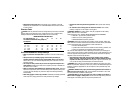
10
WARNING: To reduce the risk of
FIG. 4
DRILLING
C
personal injury, ALWAYS ensure
workpiece is anchored or clamped firmly.
If drilling thin material, use a wood
“back-up” block to prevent damage to
the material.
1. Use sharp drill bits only. For WOOD,
use the low speed setting and twist
drill bits, spade bits, power auger
bits, or hole saws. For METAL, use
the low speed setting and steel
twist drill bits or hole saws. For
MASONRY, such as brick, cement,
cinder block, etc., use carbide-tipped bits rated for percussion drilling. Use low
speed for bits greater than 10 mm (3/8").
2. Always apply pressure in a straight line with the bit. Use enough pressure to keep
drill biting, but do not push hard enough to stall the motor or deflect the bit.
3. Hold tool firmly with both hands to control the twisting action of the drill. If model
is not equipped with side handle, grip drill with one hand on the handle and one hand
on the battery pack.
CAUTION: Drill may stall if overloaded causing a sudden twist. Always expect the
stall. Grip the drill firmly to control the twisting action and avoid injury.
4. IF DRILL STALLS, it is usually because it is being overloaded or improperly used.
RELEASE TRIGGER IMMEDIATELY, remove drill bit from work, and determine
cause of stalling. DO NOT CLICK TRIGGER ON AND OFF IN AN ATTEMPT TO
START A STALLED DRILL — THIS CAN DAMAGE THE DRILL.
5. To minimize stalling or breaking through the material, reduce pressure on drill and
ease the bit through the last fractional part of the hole.
6. Keep the motor running when pulling the bit back out of a drilled hole. This will
help prevent jamming.
7. With variable speed drills there is no need to center punch the point to be drilled.
Use a slow speed to start the hole and accelerate by squeezing the trigger harder
when the hole is deep enough to drill without the bit skipping out.
Hammerdrill Operation (Fig. 5)
1. Turn the collar (C) to the
HAMMERDRILLING
FIG. 5
C
hammerdrill symbol.
2. Select the high speed setting by
sliding the selector back (away
from the chuck).
IMPORTANT: Use carbide-tipped
or masonry bits only.
3. Drill with just enough force on the
hammer to keep it from bouncing
excessively or "rising" off the bit.
Too much force will cause slower
drilling speeds, overheating and
lower drilling rate.
4. Drill straight, keeping the bit at a right angle to the work. Do not exert side
pressure on the bit when drillling as this will cause clogging of the bit flutes and a
slower drilling speed.
5. When drilling deep holes, if the hammer speed starts to drop off, pull the bit
partially out of the hole with tool still running to help clear debris from the hole.
NOTE: A smooth, even flow of dust from the hole indicates proper drilling rate.
MAXIMUM RECOMMENDED CAPACITIES
DC725-XE, DCD775-XE,
DC727-XE, DC737-XE
DC720 DC730, DC743
Size Speed Size Speed Size Speed
WOOD
Auger 22 mm (7/8") 1 22 mm (7/8") 1 10 mm (3/8") 1
Paddle 25 mm (1") 2 25 mm (1") 2 38 mm (1") 2
Twist 13 mm (1/2") 1–2 13 mm (1/2") 1–2 10 mm (3/8") 1–2
METAL
Twist 13 mm (1/2") 1–2 13 mm (1/2") 1–2 10 mm (3/8") 1–2
MASONRY
Carbide 6.35 mm (1/4") 2 – – – –


















